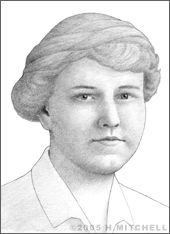Anna Keichline
Anna Wagner Keichline was born in Bellefonte, Pennsylvania in 1889. By the time she was a teenager, it was clear that she was an extraordinary woman who wasn’t going to let the era’s gender barriers hold her back from pursuing her goals. One of four children, her parents encouraged her to develop her natural talent for carpentry and mechanics. She was fortunate enough to have been given her own carpentry tools and a home workshop, and by age fourteen, she was locally known as a skilled craftswoman after winning a prize at the Centre County Fair for an oak table that she built herself.
In 1906, Keichline graduated from Bellefonte High School and went on to study mechanical engineering at Pennsylvania State College. Just a year later, she transferred to Cornell University to pursue an architectural degree. She believed that women were well suited to this field, especially since they had intimate knowledge and understanding of how a household functions and how various rooms in a home, particularly kitchens, would be used by its occupants. She designed an improved, space-saving sink and washtub, which she patented in 1912, a year after graduating from Cornell with her BA in Architecture.
In 1920, Keichline became the state of Pennsylvania’s first registered female architect. She designed buildings in Pennsylvania, Ohio, and Washington D.C., and continued to come up with ideas for improved household environments. In 1924, she earned a patent for a kitchen design that included sloped counter tops and clear glass cabinets to make cleaning and organizing easier. In 1929, she patented a bed for a small apartment that could be folded into the wall.
Keichline received seven patents over the course of her lifetime. Her most famous invention was a brand new building component she designed known as the “K Brick.” Keichline’s K Brick was an inexpensive, light, fireproof clay brick that was used for hollow wall construction. It could be filled with soundproofing or insulating materials, making it versatile and efficient. The K Brick led to the development of today’s concrete block. She patented the design in 1927 and was honored by the American Ceramic Society in 1931.
Not only was Keichline successful in her architectural career, but she was also active on a national level with causes such as women’s suffrage and President Herbert Hoover’s Better Housing Conference. She participated in World War I as a special agent for military intelligence. She also owned and enjoyed repairing her own car.
She died in 1943, and her great niece, Nancy Perkins, carried on her legacy by establishing her own industrial design firm, Perkins Design Ltd. Perkins has also been awarded several patents for improved household appliances, including vacuum cleaners and car batteries.


